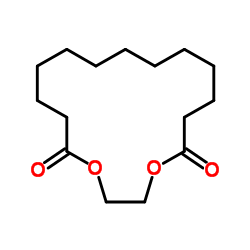Ethylene brassylate

Ethylene brassylate structure
|
Common Name | Ethylene brassylate | ||
|---|---|---|---|---|
| CAS Number | 105-95-3 | Molecular Weight | 270.365 | |
| Density | 1.042 | Boiling Point | 476.1±28.0 °C at 760 mmHg | |
| Molecular Formula | C15H26O4 | Melting Point | N/A | |
| MSDS | Chinese USA | Flash Point | 243.9±22.4 °C | |
| Symbol |

GHS07 |
Signal Word | Warning | |
Use of Ethylene brassylate1,4-Dioxacycloheptadecane-5,17-dione is a biochemical reagent that can be used as a biological material or organic compound for life science related research. |
| Name | Ethylene brassylate |
|---|---|
| Synonym | More Synonyms |
| Description | 1,4-Dioxacycloheptadecane-5,17-dione is a biochemical reagent that can be used as a biological material or organic compound for life science related research. |
|---|---|
| Related Catalog |
| Density | 1.042 |
|---|---|
| Boiling Point | 476.1±28.0 °C at 760 mmHg |
| Molecular Formula | C15H26O4 |
| Molecular Weight | 270.365 |
| Flash Point | 243.9±22.4 °C |
| Exact Mass | 270.183105 |
| PSA | 52.60000 |
| LogP | 2.90 |
| Vapour Pressure | 0.0±1.2 mmHg at 25°C |
| Index of Refraction | 1.47 |
CHEMICAL IDENTIFICATION
HEALTH HAZARD DATAACUTE TOXICITY DATA
|
| Symbol |

GHS07 |
|---|---|
| Signal Word | Warning |
| Hazard Statements | H315 |
| Personal Protective Equipment | Eyeshields;full-face respirator (US);Gloves;multi-purpose combination respirator cartridge (US);type ABEK (EN14387) respirator filter |
| Hazard Codes | Xi:Irritant; |
| Risk Phrases | R38 |
| Safety Phrases | S26-S36 |
| RIDADR | NONH for all modes of transport |
| WGK Germany | 2 |
| RTECS | YQ1927500 |
| HS Code | 2932999099 |
|
~% 
Ethylene brassylate CAS#:105-95-3 |
| Literature: Journal of the American Chemical Society, , vol. 57, p. 935 |
|
~% 
Ethylene brassylate CAS#:105-95-3 |
| Literature: Iuchi, Yosuke; Obora, Yasushi; Ishii, Yasutaka Journal of the American Chemical Society, 2010 , vol. 132, p. 2536 - 2537 |
| HS Code | 2932999099 |
|---|---|
| Summary | 2932999099. other heterocyclic compounds with oxygen hetero-atom(s) only. VAT:17.0%. Tax rebate rate:13.0%. . MFN tariff:6.5%. General tariff:20.0% |
|
Metrics and clinical relevance of percutaneous penetration and lateral spreading.
Skin Pharmacol. Physiol. 28(2) , 57-64, (2015) Percutaneous penetration of urea in vivo in man has been documented. If urea can penetrate the skin, it may also move laterally. Lateral spreading of topical substances leads to unpredictable penetrat... |
| Tridecanedioic acid, cyclic ethylene ester |
| Brassylic Acid Ethylene Ester |
| 1,4-Dioxacycloheptadecane-5,17-dione |
| Ethylene Glycol Brassylate |
| 1,11-Undecanedicarboxylic acid, ester with ethylene glycol |
| Ethylene Tridecanedioate |
| MFCD03427405 |
| T-17-OV EVOTJ |
| Tridecanedioic acid, cyclic ethylene ester (8CI) |
| EINECS 203-347-8 |
| Ethylene brassylate |
| Tridecanedioic acid cyclic ethylene glycol diester |


 CAS#:116754-58-6
CAS#:116754-58-6 CAS#:13362-52-2
CAS#:13362-52-2 CAS#:116452-12-1
CAS#:116452-12-1 CAS#:62873-30-7
CAS#:62873-30-7
